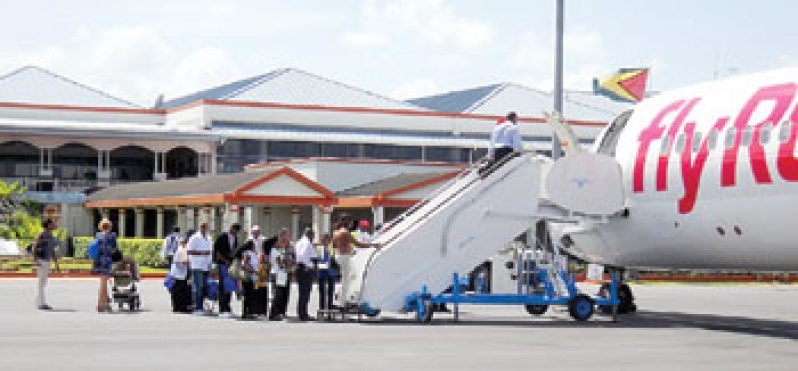SUBSIDY/OWNERSHIP ‘TALK’
REDjet blues ignite subsidy/ownership ‘talk’
WITH THE less than one-year old ‘REDjet’ airline forced to suspend flight operations in the region, welcome to ‘de javu’ in the chronic scenario of recurring failures by CARICOM governments and private sector entrepreneurs to deal with the challenges of regional air transportation—including the critical factor of ownership.  This quite dramatic financial crisis development for REDjet has ignited new ‘talk’ about subsidy for and ‘ownership’ of regional airlines, but with no official stirrings of significance, as yet, in two of the major centres of CARICOM—Trinidad and Tobago and Jamaica—both still preoccupied in making a success of their merger of Caribbean Airline and Air Jamaica.
This quite dramatic financial crisis development for REDjet has ignited new ‘talk’ about subsidy for and ‘ownership’ of regional airlines, but with no official stirrings of significance, as yet, in two of the major centres of CARICOM—Trinidad and Tobago and Jamaica—both still preoccupied in making a success of their merger of Caribbean Airline and Air Jamaica.
To hear REDjet’s senior personnel seeking to justify the sudden shutdown of operations as of last Friday evening, after a very recent boastful official claim (though unsubstantiated), that the airline had “an excellent” financial year in 2011, is to rub salt to the wounds of stranded CARICOM nationals currently being rescued by regional airline, LIAT.
Further, to learn from REDjet’s Chief Executive Officer, Ian Burns, that his company was now “hoping to receive government subsidies, as do other airlines, to help restart service”, would raise more troubling questions about the evident lack of an enlightened air transportation policy by CARICOM governments in the service of a region of scattered islands and mainland territories divided by the sea and heavily dependent on tourism, trade and services. While REDjet’s Burns has been speculating on “subsidies”, some knowledgeable about the regional/international airline business think that—to use the language of cricket—“the pitch is already being rolled” to justify the case for government’s intervention with subsidy.
While REDjet’s Burns has been speculating on “subsidies”, some knowledgeable about the regional/international airline business think that—to use the language of cricket—“the pitch is already being rolled” to justify the case for government’s intervention with subsidy.
The intention, it seems, is for this to be achieved with pressures on governments, while diverting attention away from the failed carrier that has been so vigorous in marketing itself as a reliable low-cost enterprise– even in the face of recurring mechanical problems with aircraft, sudden changes in flight schedules, and complaints from affected passengers.
It is to be wondered what the scenario would have been like had LIAT, for example, suddenly shutdown flight operations in even one of the regional destinations it has been serving during its now 55 years of operations as CARICOM’s oldest airline, compared with the “soft landing” that REDjet has so far received from even some government and business leaders in Caricom.
The reality is that while LIAT continues, warts and all, to provide unprecedented communication linkages for the people of the Caribbean region—well beyond the boundaries of CARICOM–it has long ceased to receive any subsidy from governments and, had it not been for the vision and commitment of three of its major shareholders—Barbados, Antigua and Barbuda and St. Vincent and the Grenadines—it may well have gone the way of those of its short-lived “competitors” on intra-regional routes
Litany of woes
Among the litany of woes, as readers may recall, were, for example, ‘BWEE Express’ (subsidiary of then BWIA); Air Jamaica; ‘CaribExpress’ and, finally its achievement in acquiring “Caribbean Star’ and ‘Caribbean Sun’, carriers of the now convicted American tycoon, Allen Stanford—long before he was able to fulfill his boast to run LIAT out of business.
But to hear even voices of significance in the public sector warning of “monopolies” in regional air transportation is quite puzzling, as LIAT, for one, has to continue coping with competing air carriers, including from North America as well as Caribbean Airlines, the latter enjoying an estimated US$75M annual fuel subsidy from government.
This subsidy is not a recent development, and has been and continues to be defended in the national interest of its owner—Trinidad and Tobago—while critical oversight on management is on the increase.
Ownership of airlines in a single Caribbean airspace has long been a consideration of successive administrations in CARICOM, but to date it continues to be an elusive issue for decision.
As far back as January 1981, a high-level team of Caribbean experts, chaired by the now late William Demas, then President of the Caribbean Development Bank, had called for existing national companies to get together and create either a Caribbean airline holding company, or a regional leasing company.
They provided the various options/alternatives for consideration and action, with an emphasis on the major issues in air transportation being in respect of the need for an “efficient intra-regional service and a rationalized and effective service by the various regionally-owned airlines operating extra-regionally…”
No development of significance emerged among our governments for almost two decades, before a few heads of governments of the Eastern Caribbean met in Port-of-Spain with then Prime Minister Patrick Manning, to face the tough choices in relation to ownership to meet intra-regional and extra-regional air transportation needs. But that also proved to be a weekend wonder as there remains no changes of relevance in the status quo.
Question for the moment is whether any government of our Caribbean Community would risk talking seriously about a subsidy—in whatever form or nature—for the failed REDjet airline, while LIAT continues to struggle to satisfy growing demands for improved services amid escalating costs as the carrier that pays more than most, if not all, to operate from the intra-regional destinations it serves.
REDJET ‘ BLUES’ IGNITE NEW
SHARE THIS ARTICLE :
Facebook
Twitter
WhatsApp




.png)









